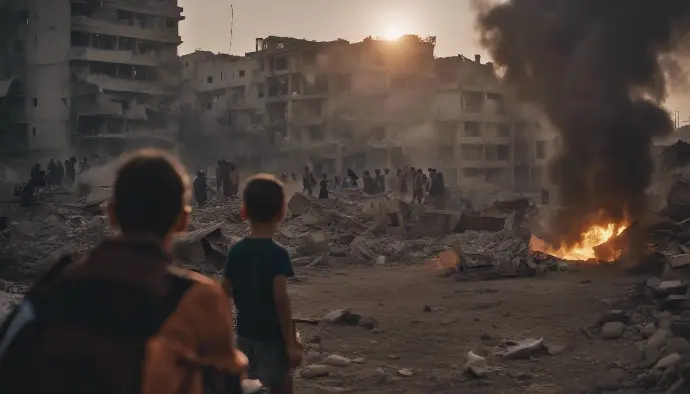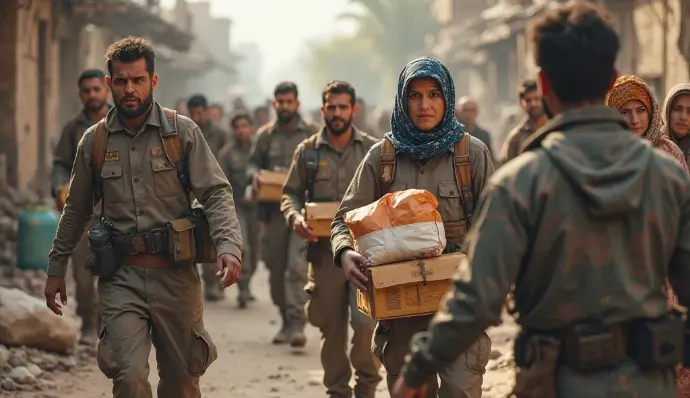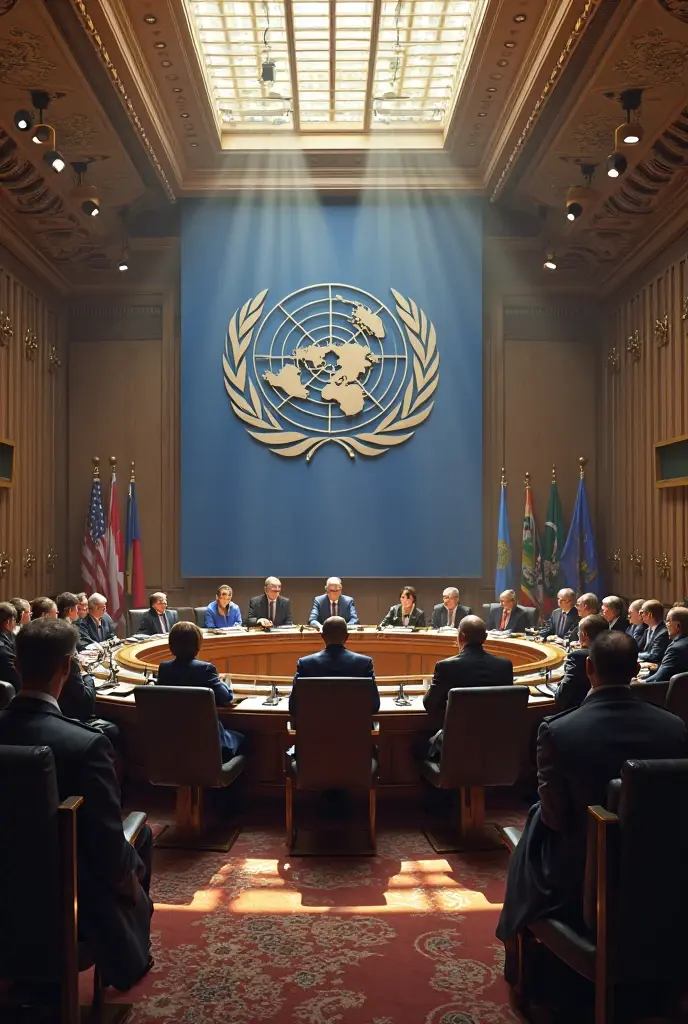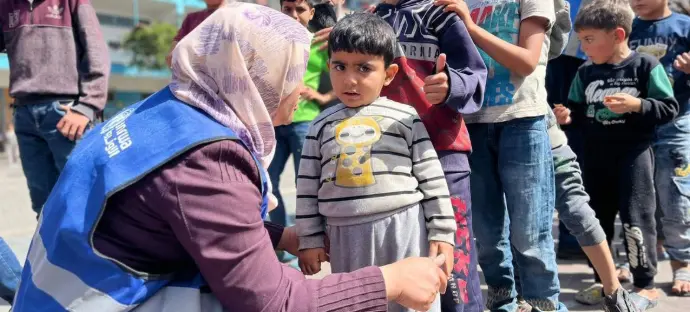This article presents a detailed analysis of the role of international humanitarian law in conflict resolution, a key topic in our section on Law in Situations of Armed Conflict. Get ready to delve into a comprehensive study that will allow you to appreciate the relevance of this topic in the global context. Don't miss this opportunity to understand how international humanitarian law can influence conflict resolution!
Introduction to International Humanitarian Law
International Humanitarian Law (IHL) plays an essential role in the resolution of armed conflicts by establishing guidelines that seek to safeguard persons not participating in hostilities and limit the repercussions of war. Its relevance lies in its ability to humanize conflicts, alleviate the suffering of civilians, and promote respect for human dignity in situations of war.
The primary objective of IHL is to protect those not involved in hostilities, such as civilians, the wounded, the sick, prisoners of war, and other vulnerable groups. By imposing restrictions on the use of force and regulating the behavior of parties to the conflict, IHL helps reduce the humanitarian consequences of war and safeguard the fundamental rights of people affected by armed conflict.
IHL also encourages the search for peaceful solutions to conflicts, promoting dialogue, negotiation, and mediation as alternatives for resolving disputes without resorting to violence. In this way, it contributes to building peace and stability in areas affected by armed conflict, laying the foundations for sustainable development and the promotion of human rights.
International Humanitarian Law (IHL) is governed by principles aimed at safeguarding humanity in armed conflict. These include the distinction between combatants and civilians, the prohibition of causing unnecessary suffering, proportionality in the use of force, and the protection of those not participating in hostilities. Its purpose is to preserve human dignity and guarantee respect for fundamental rights even in the most adverse circumstances, such as war and armed violence.
The practical implementation of these principles defines both ethically and legally the manner in which hostilities are conducted. They promote respect for life, physical and psychological integrity, as well as for civilian objects. They also facilitate the provision of humanitarian assistance to those in need, while seeking to reduce unnecessary suffering and provide special protection to vulnerable populations, including children, women, the elderly, and persons with disabilities.
As an essential normative framework, the principles of IHL regulate the behavior of parties to a conflict. Its main purpose is to mitigate the consequences of conflicts on the civilian population, promoting respect for dignity and human rights in the midst of situations of violence and armed conflict.
The implementation of International Humanitarian Law (IHL) in contexts of armed conflict is carried out through the promotion, compliance, and dissemination of its principles and provisions, both nationally and internationally. To this end, States, international organizations, non-governmental entities, and other relevant actors play an essential role, which includes the adoption of legal regulations, the training of armed forces, and raising public awareness of the importance of complying with these norms.
Similarly, collaboration and support between States, humanitarian organizations, and other actors involved in the management of humanitarian crises are key to ensuring the protection of people affected by conflict. This includes the provision of humanitarian assistance, as well as the promotion of peace and reconciliation in affected communities.
Within this framework, the objective of IHL is not limited to safeguarding the civilian population or mitigating the devastating effects of war. It also seeks to lay the foundations for peaceful conflict resolution, promote post-war reconstruction, and foster a sustainable culture of peace in societies affected by armed violence.
The origin of International Humanitarian Law (IHL) dates back to the dawn of civilization, where norms and practices seeking to protect the wounded and prisoners of war were already evident in ancient cultures such as the Greeks and Romans. However, a major turning point occurred in the 19th century, during the Napoleonic Wars. Henry Dunant, after witnessing the terrible suffering of wounded soldiers at the Battle of Solferino, promoted the creation of the Red Cross and advocated for international treaties guaranteeing the protection of victims in armed conflicts.
The First Geneva Convention, signed in 1864, laid the foundations for IHL, initially focusing on the protection of the wounded and sick on the battlefield. Over time, new treaties and protocols were enacted that expanded its scope, promoting the humanitarian treatment of prisoners of war, the protection of civilians trapped in conflict zones, and the prohibition of certain methods and weapons, such as chemical and biological weapons.
Over the years, IHL has undergone constant evolution to meet the challenges of contemporary armed conflicts. Today, it constitutes a comprehensive body of law that protects all those who do not directly participate in hostilities, as well as those who end up under the control of one of the warring parties. Its main purpose is to reduce human suffering during wars and guarantee respect for the dignity and fundamental rights of those affected by these situations.

The Role of International Humanitarian Law in Conflict Resolution
International Humanitarian Law (IHL) plays a crucial role in safeguarding civilians trapped in armed conflict. This set of rules seeks to contain the devastating effects of violence in times of war by establishing measures to protect those not directly involved in hostilities. Among its key provisions, IHL prohibits indiscriminate attacks, the use of weapons that cause unnecessary harm, and strategies that put civilian lives at risk. It also imposes on the parties involved in the conflict the responsibility to ensure safe access of humanitarian aid to the most vulnerable populations.
The core of IHL is minimizing human suffering during conflicts, promoting the differentiation between combatants and civilians and paying special attention to those who remain outside the conflict. This protection extends to the wounded, sick, prisoners of war, and civilian communities, with the aim of preserving their dignity and ensuring respect for their fundamental rights even in the midst of adverse circumstances. The proper implementation of IHL contributes significantly to reducing the destructive consequences of armed conflict on civilian populations, strengthening the protection of life and the integrity of those affected by the horrors of war.
The effective implementation of International Humanitarian Law (IHL) for conflict resolution faces various challenges in practice. One of the most significant challenges is the lack of political will on the part of actors involved in armed conflicts to respect the rules of IHL. Parties to conflict often prioritize their military or political objectives over the protection of civilians and other non-combatants, which hampers the effective application of humanitarian law.
Another significant challenge lies in the difficulty of ensuring compliance with and respect for IHL in environments where state structures have collapsed or are extremely fragile. In these circumstances, humanitarian organizations and peacekeeping missions may face significant obstacles in accessing affected areas, limiting their ability to monitor and enforce IHL.
Furthermore, the lack of accountability for IHL violations represents a critical obstacle to its effective implementation. When those responsible for violations of IHL are not brought to justice, whether at the national or international level, it sends a message of impunity that undermines the fundamental principles of IHL and hinders its application in future conflicts.
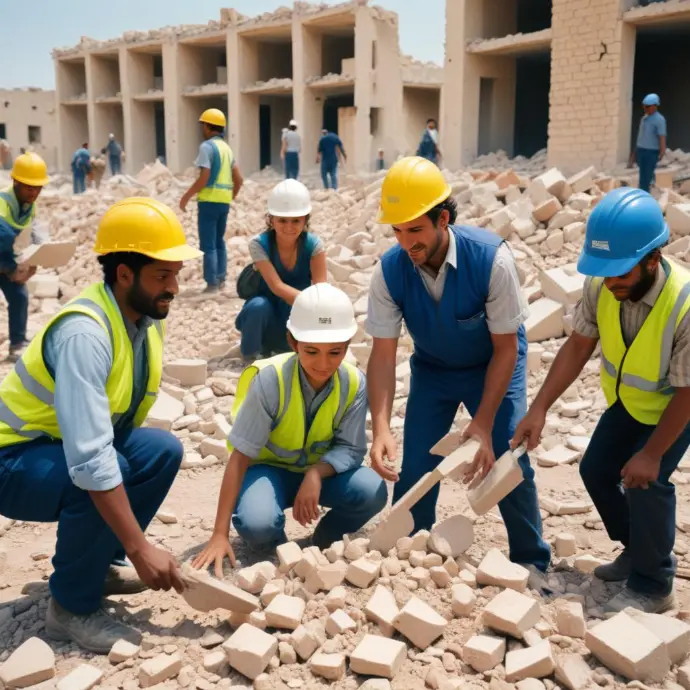
International Humanitarian Law as a Pillar for Sustainable Peace
International humanitarian law (IHL) plays an essential role in promoting peace and reducing the devastating effects of armed conflict on civilian populations. This set of rules, also known as the law of war, aims primarily to protect those who are not or no longer participating in hostilities, as well as to restrict the methods and means used during armed confrontations.
Through key principles, such as the differentiation between combatants and civilians, the prohibition of indiscriminate attacks, and unwavering respect for human dignity, IHL provides fundamental tools to facilitate the peaceful resolution of conflicts. By safeguarding the basic rights of people in conflict situations, this legal framework contributes significantly to building a solid and lasting peace.
Additionally, IHL reinforces the importance of accountability for human rights violations committed in war contexts, thus promoting reconciliation processes and facilitating the reconstruction of societies fractured by violence. Recognizing the vital role of this legal system in consolidating peace, it is essential to strengthen its application and ensure its effective enforcement in all conflict scenarios worldwide.
The role of international humanitarian law in post-conflict reconciliation processes is key to restoring social cohesion and establishing the foundations for sustainable peace after the end of an armed conflict. This legal framework offers fundamental guidelines that support forgiveness, transitional justice, and reparation for victims' rights.
International humanitarian law contributes to reconciliation by establishing standards that seek to guarantee non-impunity for war crimes and serious human rights violations. Furthermore, it fosters the search for truth and promotes accountability, essential elements for consolidating peace and preventing the resurgence of new episodes of violence.
By recognizing the suffering of victims and ensuring justice, IHL plays an essential role in restoring the social fabric affected by conflict. Its proper application is essential for impacted communities to heal their wounds and move toward a future based on peaceful and lasting coexistence.
Strengthening legal frameworks based on international humanitarian law is key to effectively addressing armed conflicts. These frameworks provide essential support for promoting peace negotiations, establishing ceasefire agreements, and facilitating reconciliation processes, while defining clear responsibilities for the protection of civilians and compliance with humanitarian norms.
By defining principles and rules that delimit the conduct of parties to a conflict, IHL fosters an environment conducive to the peaceful resolution of disputes. The creation of specific regulations aimed at protecting vulnerable groups, such as women, children, and persons with disabilities, demonstrates IHL's commitment to equality and the comprehensive protection of those directly impacted by armed conflict.
In essence, international humanitarian law plays a fundamental role in mitigating the effects of armed conflict by establishing an essential framework for the defense of human rights, promoting reconciliation, and consolidating peace. Its effective implementation and constant evolution are essential to moving toward a global scenario in which armed conflicts are an exception rather than a constant.
Conclusions
International humanitarian law (IHL) plays a crucial role in conflict resolution around the world. As the dynamics of armed conflict evolve, IHL faces the challenge of adapting to new realities and technologies. The advancement of cyberwarfare and the use of drones raise questions about the applicability of IHL in these scenarios. It is critical that IHL continues to develop to address these new forms of conflict and protect civilians in these situations.
Furthermore, the future of IHL is also linked to conflict prevention. Promoting human rights education and raising awareness about IHL from an early age can contribute to preventing future armed conflicts. Strengthening international justice and accountability mechanisms is also crucial to ensuring that IHL is effectively applied in conflict resolution.
The future of IHL in conflict resolution lies in its ability to adapt to the new realities of armed conflict, prevent future conflicts through human rights education, and strengthen international justice mechanisms.
Currently, IHL faces various challenges in its implementation and respect. The lack of compliance with and respect for IHL by State and non-State actors in armed conflict represents one of the most significant challenges. Impunity and lack of accountability perpetuate violations of IHL and jeopardize the protection of civilians and non-combatants.
However, amid these challenges, opportunities also arise to strengthen IHL. The use of technology and data collection to monitor and document IHL violations provides an opportunity to promote accountability. Furthermore, collaboration between State actors, international organizations, and civil society can strengthen the implementation of IHL and promote a culture of respect for human rights in contexts of armed conflict.
Current times present significant challenges for IHL, but they also offer opportunities to strengthen its application and promote respect for human rights in situations of armed conflict.
International humanitarian law takes on vital importance today, where its ethical and legal compliance is essential for addressing and resolving conflicts in an increasingly globalized and turbulent world.


 IHRO NEWS
IHRO NEWS